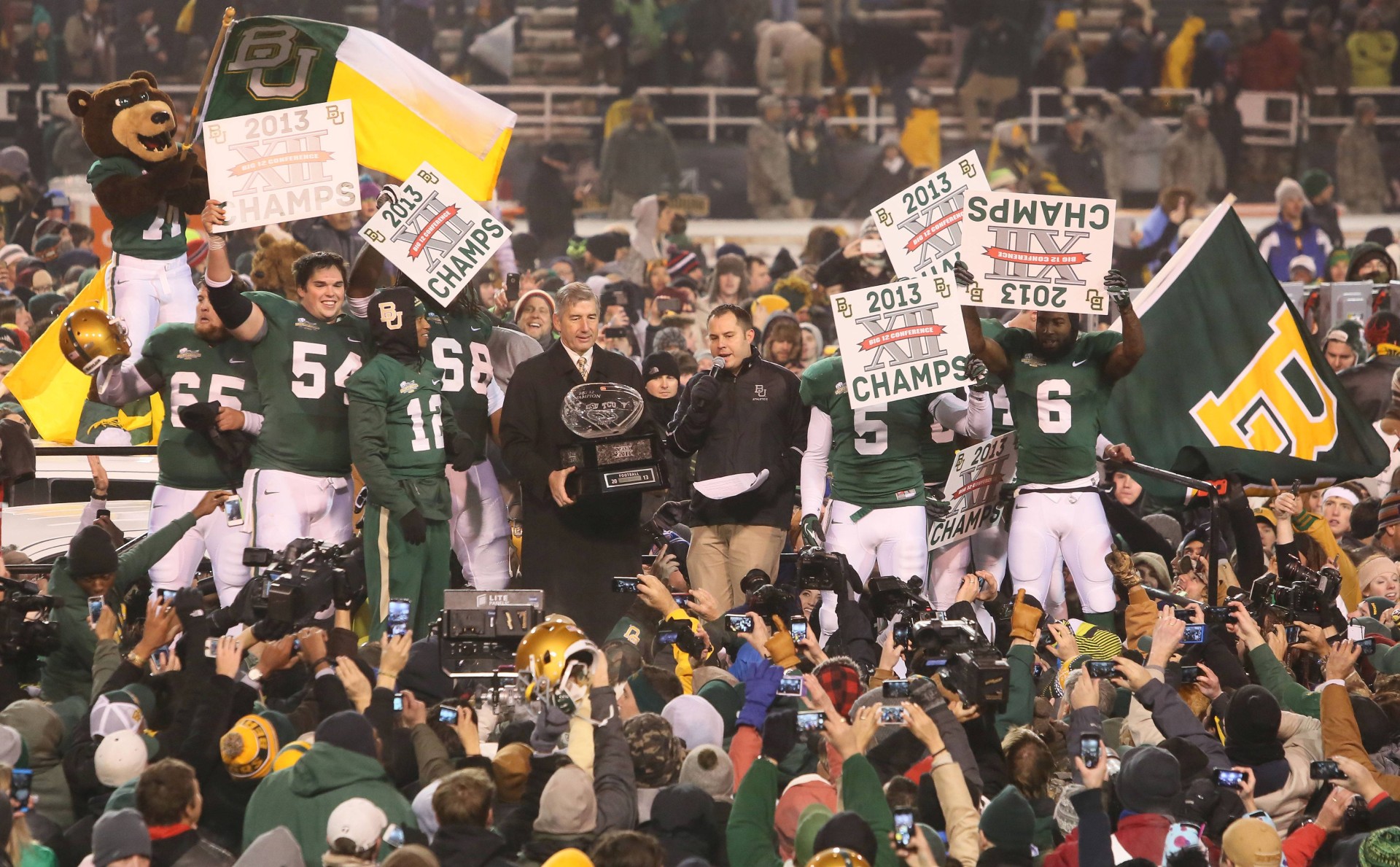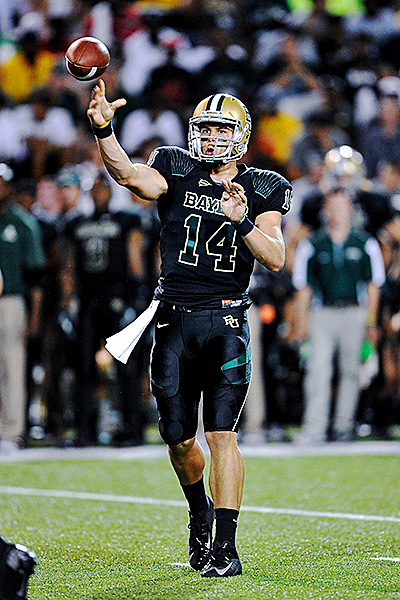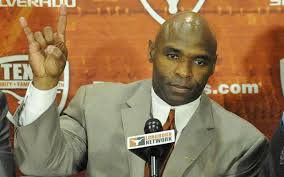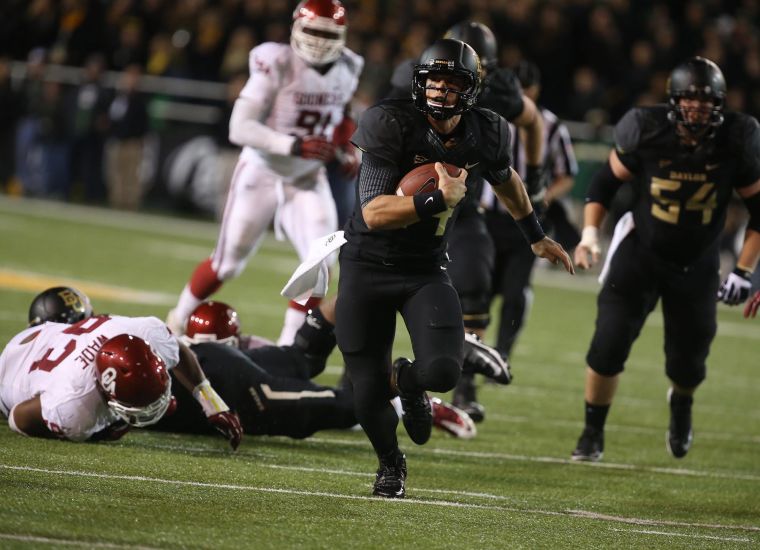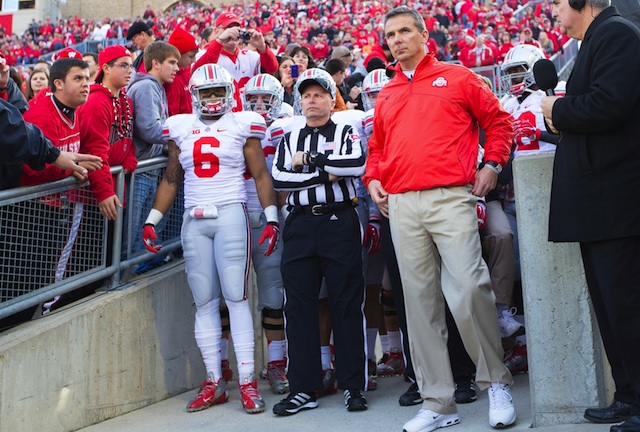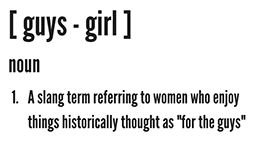Unlike the other major conferences, the Big 12 has been defined by parity. Five different schools have won the league in the past five years.
The downside of all that parity, though, is that the league’s contenders tend to beat each other up. The result is a number of solid, above-average teams that are ultimately left out of the national title picture.
The new playoff format promises to change that and should be of great benefit to the Big 12. As strong as the conference is, its champion ought to be in great position for a playoff berth.
Who that representative will be is anyone’s guess, as a case could be made for at least half the teams in the league. Will Oklahoma live up to its billing, or will Baylor defend its crown? What about Oklahoma State? Will TCU finally break through? Is Texas back? Or is this one of those year’s where Kansas State comes out of nowhere to win the league again?
2013 Year in Review
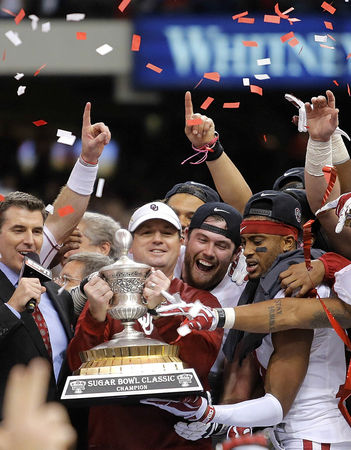
Oklahoma coach Bob Stoops celebrates with his team after defeating Alabama (David Grunfeld, Nola.com / The Times-Picayune)
Last season was an odd year for the Big 12. Longtime league titans Texas and Oklahoma have dominated the Big 12, yet it was perennial doormat Baylor that captured the conference crown behind an overpowering offense.
The Bears piled up points and yards and were a juggernaut for most of the season before running out of steam late and suffering a disappointing finish to the season with an upset loss to Central Florida in the Fiesta Bowl.
The conference did rebound when Oklahoma pulled up a stunning upset of its own in the Sugar Bowl by trouncing SEC power Alabama. It had been awhile since Big Game Bob Stoops had lived up to his moniker, and for him to lead a Sooners squad that wasn’t one of his best to such a marquee win was good for the league.
Oklahoma State quietly had another solid season while Kansas State suffered through some bad breaks before rounding into form.
Mack Brown restored Texas to prominence during his 16 years as coach, winning two Big 12 titles and one national championship. Texas made another championship game appearance in 2009—losing to Alabama—but has been in decline ever since. Brown’s tenure finally came to an end as he retired at the end of the season.
The bottom half of the conference had little to write home about. TCU was close so many times yet couldn’t muster the offense to put them over the hump. West Virginia continued its slide, and Iowa State had a forgettable year devoid of upsets. Meanwhile, Kansas was, well, Kansas.
Looking Ahead to 2014
The Top Contenders: A Blueblood Versus New Money
Senior quarterback Bryce Petty returns to lead Baylor’s offensive juggernaut after throwing for 4,200 yards and 32 touchdowns against only 3 interceptions in 2013. He’ll have plenty of weapons at his disposal as Baylor should once again make scoreboards cry. The defense was vastly improved last year, and while the secondary will be inexperience, the front seven should be quite good. Expect Baylor to contend for a second-straight Big 12 title and be in the playoff picture.
Oklahoma had a weird season last year. The Sooners had been overrated for years, and in 2013, they weren’t great. Sure, Oklahoma was good, but they weren’t elite. Then, they thrashed Alabama in the Sugar Bowl, gashing the Tide’s vaunted defense and hounding AJ McCarron. Which Oklahoma team is real, the one that throttled Alabama or the one that lost by 16 points to Texas? Is Trevor Knight the quarterback who lit up the Tide or the one that struggled against Louisiana-Monroe? Still, combine the confidence that win gives the Sooners with the talent Bob Stoops has stockpiled in Norman, and you have a Big 12 and playoff contender.
Lurking in the Weeds: Ready to Pounce if the Favorites Stumble
Oklahoma State has quietly become one of the nation’s best and consistent programs under Mike Gundy. The Cowboys were 10-3 last year and figure to play a major role in the Big 12 race yet again. OSU should once again be potent on offense as experienced quarterback J.W. Walsh returns along with leading rusher Desmond Roland and a number of talented receivers who saw playing time a year ago. The defense thrived under new coordinator Glenn Spencer, but major losses in the secondary and at linebacker are cause for concern. The biggest obstacle facing the Cowboys, however, is the schedule. In a word, it’s brutal. Oklahoma State opens on the road against defending national champion and top-ranked Florida State then spends November at Kansas State, home against Texas, and finished on the road against Baylor and Oklahoma.
At this point, it’s unfair to call Kansas State a dark horse. Under head coach/wizard Bill Snyder, the Wildcats are always in the mix. They’re not flashy and don’t sign a bunch of highly-lauded recruits, yet ever year, Kansas State seems to surprise everyone. Last year, they nearly beat both Oklahoma State and Baylor before winning six-of-their-last-seven. Depth is a concern this season, as is a defense that has to replace a lot of pieces for the second year in a row, but with several key offensive starters returning—including top-notch receiver Tyler Lockett—and Snyder’s propensity to just churn out quality teams, K-State will once again make some noise in the Big 12.
Not Quite There Yet
TCU’s move to the Big 12 hasn’t gone as planned, as the Horned Frogs have gone 11-14 since making the move. It may be easy to say it’s a case of a mid-major power not being able to hang with tougher competition week-in and week-out, but that’s not the case. Suspensions have hurt, but the biggest culprit has been poor quarterback play. TCU brought in new offensive co-coordinators—Sonny Cumbie from Texas Tech and Doug Meachem from Houston—to remedy the offense. TCU’s vaunted defense has been as good as advertised, even in a tougher conference. Despite going 4-8 last year, only one loss was by more than two scores. If the offensive changes pan out to pair with yet another stout defense, TCU could finally get over the hump and contend in the Big 12. Consider the Horned Frogs your dark horse candidate.
Optimism abounds in Lubbock after Kliff Kingsbury’s first year at the helm. Texas Tech jumped out to a 7-0 start, lost its next five, then steamrolled Arizona State to end the year on a high note. Kingsbury is recruiting well and has a young, experienced quarterback in Davis Webb to build around. The Red Raiders should once again be potent on offense, but the defense is a big issue. The secondary needs to be rebuilt, and that usually means trouble in the Big 12. Tech is on the rise, but they are at least a year away from seriously challenging for the conference title.
Can Charlie Strong Right the Ship?
Texas enters 2014 with more uncertainty than it has had in some time. For the first time in almost two decades, there will be a new coach on the sideline. Charlie Strong has tremendous success at Louisville, but how will he handle the pressure-cooker that is Texas? More importantly, how will he do with a roster loaded with talent that has failed to live up to its lofty expectations?
The Bottom of the Barrel
It’s hard to believe it’s actually true, but at one point in 2012, West Virginia was undefeated and ranked fifth in the BCS. Since then, the Mountaineers are 6-14, including 4-8 in 2013. Injuries and inexperience were a huge factor, but the flip side is that a lot of players gained plenty of experience a year ago while taking their lumps. However, while the Mountaineers should be better, it may not matter as their schedule is brutal. West Virginia starts the season with Alabama, has to go to Maryland, hosts Oklahoma, then has to run the gauntlet of Texas Tech, Baylor, Oklahoma State, TCU, Texas, and Kansas State.
Iowa State is one of the toughest jobs in the country, and while Paul Rhoads has done a commendable job, he doesn’t have much margin for error. That was evident in 2013 as the Cyclones went 3-9. The big culprit was an offense that was plagued by spotty quarterback play and had trouble producing big plays. Former Kansas head coach Mark Mangino was brought in to oversee the offense, and he certainly has the track record and experience to suggest he can turn things around (after all, he did take Kansas—KANSAS!—to the Orange Bowl). Mangino will need to work his magic because a porous run defense lost most of its experienced players. Throw in a nasty early schedule–reigning FBS champ North Dakota State, Iowa, Oklahoma State, Kansas, State, and Baylor—and it’s looking like another long year in Ames.
Oh Kansas. The Jayhawks tripled their win total from the year before, but that only means 1-11 went to 3-9. The defense improved considerably, but a woeful offense somehow got even worse. It may not get better any time soon, either. Charlie Weiss sought a short-term fix by signing a ton of JUCO players; once they graduate, there won’t be much depth and experienced younger players, and the Jayhawks will be right back where they started. There just isn’t enough talent on this team, and Weis’ track record doesn’t exactly inspire confidence. Kansas will once again reside in the Big 12 cellar.
Conference Champion
Baylor
Oklahoma is the popular pick to win the conference after the Sooners dismantled Alabama in the Sugar Bowl, but basing projections off of bowl performances is never a good idea. Remember when West Virginia destroyed Clemson in the Orange Bowl a couple of years ago? How did that turn out? The Mountaineers started the year in the top ten but finished it unranked.
Yes, Oklahoma played a great game, but other than that performance, the Sooners were a good, but not elite, team. They’ll be good again in 2014, but they won’t live up to the expectations created after their big win.
Baylor, on the other hand, played at an elite level pretty much the entire year until injuries finally caught up to them. The Bears will have a potent offense and solid defense, and Bryce Petty is a known quantity while Trevor Knight is still unproven.

